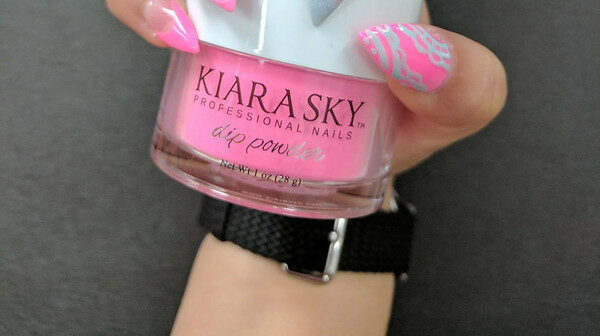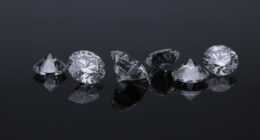Dipping powder is known for its easy application and variety of colors, while acrylic powder offers more versatility in terms of shaping and sculpting. If you’re looking for a quick and simple manicure at home, dipping powder might be your best bet. However, if you want more control over the shape and length of your nails, acrylic powder may be a better option.
Dipping powder
(Photo By Jenny Nguyen on Flickr)

Dipping powder, also known as SNS (Signature Nail Systems) or dip nails, is a popular alternative to traditional nail polish and acrylics. It involves applying a base coat, dipping your nails into a colored powder multiple times, brushing off excess powder, and finishing with a topcoat.
One of the benefits of using dipping powder is its durability. It can last up to 4 weeks without chipping or fading. Additionally, it’s healthier for your natural nails because it doesn’t require any harsh chemicals like monomer used in acrylics.
Another advantage of dipping powders is their wide range of colors and finishes. From glittery to matte shades and even french tip designs, there are endless possibilities to choose from.
However, there are also some drawbacks when it comes to using dipping powders. The application process can be time-consuming and messy if not done correctly. Also, removing the product requires soaking your nails in acetone which can weaken them over time.
While there are pros and cons to using dipping powders on your nails – they’re definitely worth trying out!
Acrylic powder
(Photo By Freepik)

Acrylic powder is a popular nail enhancement product that has been around for decades. It’s made by mixing a polymer and monomer to create an acrylic paste, which is then applied to the natural nails or tips. Once the paste hardens, it can be shaped and buffed into the desired look.
One advantage of using acrylic powder is its durability. Acrylics are known for being strong and long-lasting, making them ideal for those who have weak or brittle nails. With proper care, they can last up to three weeks before needing a fill-in.
Another benefit of using acrylic powder is its versatility. With various colors and finishes available, you can get creative with your designs and experiment with different styles. Plus, since it dries quickly under UV light, you won’t have to wait long before showcasing your new manicure.
However, there are also some drawbacks to consider when using acrylic powder. For one thing, the fumes produced during application can be quite strong and may irritate sensitive eyes or noses. Additionally, overuse of acrylics can cause damage to the natural nails if not properly maintained or removed.
While there are pros and cons associated with using acrylic powder on your nails; it remains a popular choice among many women worldwide due to its strength & versatility in design options!
Dipping powder Vs. Acrylic powder – Key differences
Dipping powder and acrylic powder are both popular nail enhancement techniques in the beauty industry. However, there are a few key differences between the two.
One of the main differences is their application process. Dipping powder involves coating the nails in a base coat, dipping them into colored powder, and then sealing them with an activator. On the other hand, acrylic powder requires mixing liquid and powdered polymers to form a paste that is applied to the nails using a brush.
Another difference is their durability. Dipping powders tend to be more durable than acrylics since they contain bonding agents that help create a strong hold on the nails. Acrylics can also be prone to chipping or lifting if not applied correctly.
When it comes to removal, acetone-soaked cotton balls or foils are used for both methods; however, removing dipping powders tend to be easier as they dissolve faster compared to acrylics.
Dipping powders come in pre-mixed colors while acrylics require mixing different shades together before applying them onto your nails.
Choosing between dipping and acrylic powders depends on personal preference and needs for nail enhancement.
How to use dipping powder and acrylic powder?
When it comes to using dipping powder and acrylic powder, there are some key differences in the application process.
To use dipping powder, first, start by buffing and cleaning your nails thoroughly. Next, apply a base coat to each nail one at a time before immediately dipping the nail into the jar of colored dipping powder at a 45-degree angle. Tap off any excess powder and then repeat this step until you get the desired shade intensity.
For acrylic powder application, mix equal parts of liquid monomer with acrylic powder on a dish or palette. Then dip your brush into this mixture before placing it onto your nails starting from one side and moving towards another while shaping as desired.
It’s important to remember that both techniques require practice for perfect results, so don’t be afraid to experiment!
The benefits of using dipping powder and acrylic powder
There are a range of benefits to using dipping powder and acrylic powder for your nails. Firstly, both options provide long-lasting wear that can withstand daily activities without chipping or breaking easily. This is particularly useful if you have an active lifestyle.
One benefit of dipping powder is that it requires no curing time under UV light, making the application process quicker than acrylics. Additionally, the odorless formula makes it a great choice for those who are sensitive to strong smells.
Acrylic powder, on the other hand, offers greater flexibility in terms of customization as you can add different colors and designs directly into the mix before applying it to your nails. They also bond well with natural nails and offer more strength than dipping powders.
Both options offer versatility in terms of shape, length and style allowing you to create unique looks depending on your preference. Whether you choose dipping or acrylic powders will depend on personal taste but rest assured that both choices come packed with their own set of benefits.
The drawbacks of dipping powder and acrylic powder
While dipping powder and acrylic powder have their benefits, they also come with drawbacks that must be considered. One of the main issues with both is that they can damage the natural nail if applied or removed improperly.
Dipping powder requires a base coat to be applied, which can cause the nails to become weaker over time. Additionally, if not properly sanitized between uses, there is a risk of infection. Furthermore, it can be difficult to remove without professional help, which means extra costs and time for maintenance.
Acrylic powder has similar concerns as dipping powder in terms of weakening the natural nail and risk of infection if proper sanitation measures are not taken. It also emits strong fumes during application that may cause respiratory problems for some individuals.
Both types of powders require skillful application techniques that may take practice to perfect. They also require consistent upkeep every few weeks to maintain their appearance.
While these products offer beautiful manicure options, users must consider potential drawbacks before making a decision on what type of product works best for them and their lifestyle.
Which product is better for specific nails?
When it comes to deciding which product is better for specific nails, there are several factors to consider. Firstly, the natural nail condition should be taken into account. If you have weakened or damaged nails, dipping powder can provide a stronger protective layer compared to acrylic powder.
Secondly, consider your desired nail length and shape. Acrylic powder is more versatile in creating custom shapes and lengths on longer nails than dipping powder.
For those who prefer frequent color changes or like experimenting with various designs, dipping powder may be a better choice as it allows for easy removal without damaging the natural nail.
On the other hand, if you prefer a more permanent look or require long-lasting wear due to work or lifestyle demands, acrylic powder may be a better option as it can last up to 3-4 weeks without chipping or peeling.
Ultimately, choosing between dipping and acrylic powders come down personal preference and taking into consideration individual needs of your natural nails.
How to remove dipping powder and acrylic powder?
Removing dipping powder and acrylic powder is an important step in maintaining healthy nails. It’s essential to remove them correctly to avoid damaging your natural nail bed.
To remove dipping powder, you’ll need acetone, aluminum foil, cotton balls or pads, and a cuticle pusher. First, use the cuticle pusher to gently lift the edges of the dip powder off your nails. Then soak a cotton ball or pad in acetone and place it on top of each nail. Wrap each finger with aluminum foil and let it sit for 10-15 minutes before removing the foil and wiping away any remaining residue.
For acrylic powder removal, start by filing off as much of the product as possible using a coarse file. Be careful not to file down too far into your natural nails. Afterward, submerge your fingertips in acetone for about 15 minutes until they are soft enough to be scraped off easily with an orange stick or metal tool.
It’s crucial not to rush during this process since excessive pressure can cause severe damage that may take months to heal properly.
Taking care of our nails is vital; removing dipping powders and acrylics properly ensures you maintain healthy-looking hands while avoiding long-term damages such as breaks or infections from poor maintenance techniques!
Featured Image By – Maria Lupan on Unsplash









